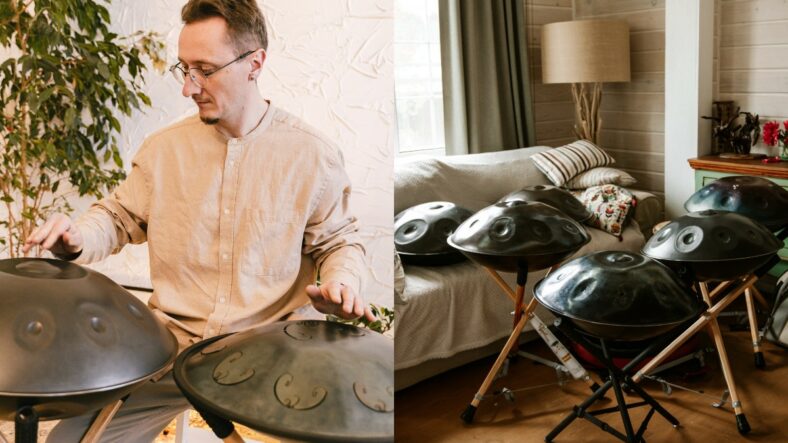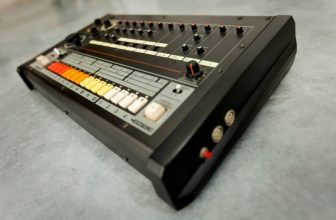Handpan Buying Guide – Advice from an Experienced Handpan Player

If you’ve ever been enchanted by the mesmerizing and ethereal sounds of a handpan, you’re not alone. These unique and captivating instruments have found their way into the hearts of musicians and enthusiasts worldwide.
I have been playing handpans for more than 7 years in different countries, festivals, events, and streets. I own 5 different handpans from different brands and countries and have tried more than 50 handpans in my life while teaching and helping my students to get their own instruments.
So, let’s delve into the world of handpans and uncover the secrets to finding the instrument that resonates with your soul for you to have your own instrument one day!
- Handpans vary in price, with quality instruments typically ranging from $1,000 to $5,000, but higher prices don’t always mean better quality.
- Choosing the right handpan involves considering factors like scale, material, size, and the number of notes, with sound quality being paramount.
- When buying a handpan, thoroughly research and evaluate sellers to ensure their reputation and credibility, and don’t hesitate to ask for references from previous customers to gauge satisfaction with the seller’s services.
- Minor scales provide a mystic, melancholic sound, while major scales offer a more uplifting and happy tone, and exotic scales bring unique flavors.
- Stainless steel is ideal for meditative, softer playing, while nitrided steel is better for a percussive approach. Ember steel offers a versatile middle ground.
- Handpan size depends on comfort, range, and portability, with 53 to 58 cm in diameter being the most common.
- More notes on a handpan provide greater musical possibilities but can introduce complexities and cost more.
- When buying a second-hand handpan, verify the seller’s credibility, request videos and photos, and consider meeting in person for the safest transaction.
Contents
- How Much Do Handpans Cost?
- How To Choose a Handpan?
- How to Choose the Scale?
- How To Choose The Right Material?
- How to Choose the Right Size for the Handpan?
- How to Choose the Amount of Notes of the Handpan?
- Do I Need a Case?
- How to find the right handpan maker?
- How do you get into contact with the maker?
- How to Pay for the Handpan?
- How to Buy a Second-Hand Handpan?
- Things To Consider When Buying a Handpan
- Tips To Avoid Scams
- Conclusion
How Much Do Handpans Cost?
The price of decent-quality handpans starts from around $1000 and goes up to $5000 even more. As handmade instruments, handpans cost slightly more than most instruments.
As handpan is a very popular instrument with a unique sound, there are many sellers trying to make money from people, selling the instruments for higher prices than usual. So, in the handpan world, higher prices do not always mean higher-quality instruments.
In the same sense, there are many producers these days, especially in Iran, turning handpan making into a mass production system. Putting quantity before quality and producing almost 3000 handpans each month! These instruments are affordable, with prices around $300, but they go out of tune very easily, and their overall quality is nowhere as good as a decent instrument.
How To Choose a Handpan?
Choosing a handpan is a pretty complex process with many questions that need to be answered. You need to consider many factors before deciding on an instrument, such as the scale, the material, the budget, the size, the maker, and more. But do not worry; I will explain all of these questions in the article, and in the end, you will be ready to choose your instrument.
But, as with any instrument purchase, my biggest advice is to trust your ears. The sound quality of an instrument is the most important aspect. It is always a good idea to try out your handpan before buying, but if you do not have the chance, a good-quality video can get the job done, too.
To get more familiar with the handpan sounds and to easily decide on the quality of a handpan, I recommend you take a pair of headphones and listen to different handpan videos on YouTube. Try to focus on 7 points:
- Tuning
- Sound balance
- Sustain
- Cross-talk
- Dynamic range
- Harmonics
So, a good handan should be almost perfectly in tune, it should have a nice sound balance between different notes, should have a good sustain, should be free of cross-talk (activation of different notes when playing a note), should be dynamically versatile to play it stronger or softer, and finally, the harmonics of each note should clearly be heard, and they should be precisely tuned.
Try to listen to some videos from different makers to judge the handpans with these 7 criteria. When you get more familiar with different handpans sounds, it will be easier for you to decide on which handpan to choose when it is time.
How to Choose the Scale?
One of the most important considerations when buying a handpan is choosing the scale. This is more of a personal choice as some people like more uplifting melodies, while others enjoy more mystic and melancholy tunes. Some will go for more Eastern scales, and others will like the classical Western melodies.
Again, here it is time to take your headphones, listen to different scales, and decide which scale really talks for you. Here is a great website from one of the best handpan producers in the world: Saraz Handpans. They have a great handpan scales section explaining and demonstrating different handpan scales for you to explore.
In summary, there are 3 main handpan scale types:
- Minor Scales: They sound more mystic and melancholic. Kurd, Mystic, Integral, Pygmy, Aeolian, Celtic, La Sirena, Harmonic Minor, and Equinox are some minor-scaled handpan examples.
- Major Scales: They sound more uplifting, happy, and epic. Pentatonic Major, Jibuk, Mixolydian, Sabye, and Yshasavita are some of the major-scaled handpans.
- Exotic Scales: These are different-sounding handpans with scales outside the Western music tradition. They sound exotic, and each has different flavors, from mystic to happy, from Middle Eastern to Chinese. Hicaz, Tarznauyun, Akebono, and Raga desh are some of the examples.
For beginners, I recommend going with a basic scale, especially if you are not familiar with music theory. Playing melodies and composing partitions are much easier with basic minor scales and major scales compared to exotic scales.
The most common handpan scale is the D Kurd scale, which is perfect for beginners as the note positions are easy on hands, and the scale is something that our ears are extremely used to from popular music.
How To Choose The Right Material?
Choosing the right material again comes down to taste and your desired approach to playing your handpan. For more meditative, slower, and softer playing, stainless steel is a great choice. For a more percussive approach, I recommend nitrided steel.
If you want a more versatile handpan that can go on both extremes, the new material, Ember Steel, is just for you.
The most common handpan material is nitrided steel, which is also the oldest material of the three. It is the hardest to maintain as it is more susceptible to rusting than the other two types. Nitrided steel handpans need to be protected well. You have to put special oils on these handpans to prevent rusting. If you have a more percussive approach and want a handpan with moderate sustain and a warm timbre, nitrided steel is the right choice.
Stainless steel handpans have been around for a while, and they offer a longer sustain, a brighter timbre, less ceramic sound, and a bigger dynamic range. They are more suitable for softer and slower playing, making them perfect for meditative sounds.
Ember steel is the last material that came to the scene from Ayasa Instruments, one of the most innovative makers around. Ember steel is a type of stainless steel that has a less rounder and wilder sound. It sits somewhere between the two aforementioned steels but is closer to the stainless steel side. Ember steel is harder to find compared to other materials, as only a few makers work with them for now. It is also the most expensive of the three materials.
There are also raw steel and steel-coated handpans, but they are highly susceptible to rust and less responsive. Also, they do not have the dynamic range of other materials. So, I do not recommend getting an instrument made with those materials.
How to Choose the Right Size for the Handpan?
When choosing the handpan, size, comfort, range, and portability are the most important factors. The number of notes on the handpan, the scale choice, and the frequency of traveling with the handpan are the main considerations when deciding on the size.
Handpans often come with diameters ranging from 45 cm to 65 cm and the height from 15 cm to 30 cm. The weight is between 2.5 kg and 4.5 kg.
The most handpans you will encounter will be between 53 to 58 cm in diameter. And that is the most important factor in the size. If you want something more portable, you can check travel handpans, which are often smaller than 50 cm in diameter, but their sound is less powerful than regular-sized handpans.
If you want a handpan with many notes, the size may get larger. Some handpans are called “mutant handpans,” which feature more than 12 notes on the top shell. These handpans have a different note layout, and sometimes their diameter can go up to 60 cm.
The scale also affects the diameter, as lower notes require larger circles. If you want a lower scale like F2, for instance, the shells need to be larger so the maker can fit the notes. If you want a larger scale, like G3 as the root note, the note circles will be smaller, which means you can go with a smaller shell.
If you are a beginner, I recommend you go with a traditional-sized shell between 53 cm to 58 cm. The best decision here will be made by the maker, as they all have different production techniques. But do not worry; they will guide you through the process, answering your questions on this issue.
How to Choose the Amount of Notes of the Handpan?
Regularly, handpans come with 8 to 10 notes. But, for a few years, there have been many makers pushing the boundaries, creating handpans with more than 20 notes on the top and bottom shells combined.
Having more notes has obvious advantages, like getting more creative with your compositions and having more range when improvising. Having lower notes than your Ding, which is the root note of the handpan, is great for changing the mood or even the scale.
But, as Uncle Ben said, with great power comes great responsibility. More notes may lead to more defects on your handpan, such as cross-talk issues, and minor flaws are more common on handpans with more notes. So, if you want a great-quality handpan with many notes, you must go with an experienced maker like Yishama, Satya, Ayasa, and others.
Also, every extra note will cost you from $50 to $100. So, if you want a handpan with 20 notes, for example, be prepared to pay quite a price.
Another part is that creating compositions with more notes requires more musical theory knowledge or at least more time with your handpan to get familiar with every progression and note.
So, if you are a beginner, I suggest you go with a regular handpan with 8 to 10 notes and maybe add some lower notes to the bottom shell if you want. So, you can create your compositions smoothly and change the mood whenever you want with lower notes and get used to playing some notes on the bottom shell, which has a slightly different feeling than playing the notes on the top shell.
Do I Need a Case?
Most of the makers include at least a soft case for your purchase for free. But, to be on the safe side and prevent any damage, it is better to have a hard case. So, when buying the instrument, ask if it comes with a case and if there is no hard case included, as for the price!
There are great hard cases that can protect your handpan from any damage. The most obvious one is Hard Case Technologies or HCT. It is the most popular hard case, and they produce great cases that can even protect your handpan in the baggage of a plane! So you can give your handpan as check-in baggage, which is a terrible idea if you do not have one of those special Aviotek Hard Cases.
Having a case is quite crucial for a handpan as handpans are sensitive and fragile instruments. Even a small bump with a soft case can get your instrument out of tune. So, having a hard case with your precious instrument is a must!
How to find the right handpan maker?
Handpan world is getting more and more diverse every day as there are many new makers joining the club each year. This is ultimately good news, but it is also getting a bit confusing when it comes to choosing a manufacturer.
There are top-tier handpan makers like Yishama, Ayasa, Satya, Veritas, ESS, Meraki, Pantheon Steel, Elaia, Jan Borren and more. These are some of the most experienced and the most trusted handpan makers from more than 150 producers today.
You can go and check their products from YouTube or their social media or official websites. You can compare scales, materials, waiting times, prices, and delivery options. I am not endorsing any of these brands or makers, and the decision is yours.
If you have the chance to go and try some instruments and brands somewhere near you, that is also an amazing opportunity to make the decision.
Even though I am not endorsing any brand, I have a black list of handpan brands to avoid. Some of these brands are Arsha, Meinl, Chill Radar Handpan, and any brand not on this list. Also, if you encounter a new handpan sold for below the $800 mark, be suspicious about the instrument.
Also, there is a great handpan community on Facebook, where you can freely ask about a new brand you encountered and get the opinions of different players and makers.
How do you get into contact with the maker?
Handpan makers often have official web pages and social media accounts that you can easily find with a basic Google search. If not, their contact can be found in the description of their YouTube videos. If you still struggle, you can ask the Facebook Handpan Instruments community.
How to Pay for the Handpan?
Unfortunately, there is no simple answer to this question. The payment methods and the procedures heavily depend on the maker and differ a lot from one to another.
However, I can give you some tips to avoid any issues. First of all, try to get as much information about the maker as you can. As there probably will be a waiting list, you will be asked for a deposit. The deposits often cost between 10% and 20% of the instrument’s final price. So, try to be sure your maker is reliable and everybody gets their instruments in the end.
You will be paying the full price before getting your instrument. But do not worry. This is the way things work in the handpan world. When your instrument is ready for shipping, the maker will send you a short video on how it sounds and looks. If everything looks okay and you approve the instrument, they will ask for the payment. If you do your research well about the makers and you trust them, you can go on and send the money so they can ship your instrument.
If it is a lesser-known brand, do your research well and ask about the maker in the handpan community. Try to learn as much as you can about them. If it is a known brand in the handpan makers list, then you have nothing to worry about!
How to Buy a Second-Hand Handpan?
Buying a second-hand handpan can be quite a tricky process. You must ensure the person is trustworthy and the instrument is in good condition. If you have the chance to meet the seller in person, everything is great, but if not, note that you are taking a risk.
Meeting with the seller in person not only ensures that you will see the instrument’s condition before the purchase but also prevents the instrument from getting damaged in the shipment process. While makers are experienced on this topic, and they know how to protect the handpan from damage during the shipment, a player may be unaware of the danger and how to wrap and protect the instrument.
Even if you can’t go and see the instrument, tell the seller you can. This way, you can see their reaction and get a hint of the seller. If they have the instrument and are not a fraud, they will be happy to show it. If they create excuses, you can start getting suspicious about them.
If you do not have the option to meet with the seller, asking for a recent video with each note played separately and slowly is a good idea. Ask them to play the harmonics separately, too. Ask for detailed photos of the instrument to see any hints of damage, rust, or bumps. Often, reliable brands have the brand name engraved on the bottom shell with the serial number of the handpan. So, you can ask about that to see if the instrument is original.
Buying a second-hand handpan without seeing the instrument is a risk. But, if you are going that road, try to learn about the seller as much as you can, and do not be hesitant to ask many questions before going on with the purchase.
The biggest second-hand handpan market is on Facebook. It is a group called “SWAP and SALE (only for handpan).” Here, you can find many handpan ads. There are many famous players also selling their instruments here. So good luck and try to be careful!
Things To Consider When Buying a Handpan
Aside from the price, there are 7 generally accepted marks of a quality handpan.
- Clear and Harmonious Sound: A quality handpan produces clear, resonant, and harmonious tones when played.
- Long Sustain: A good handpan has a long sustain, allowing the notes to ring out beautifully.
- Even Sound Across Notes: All the notes on the handpan should sound consistent in terms of volume and tone.
- Responsive Playing Surface: The playing surface should respond well to touch, making it easy to play and create expressive music.
- Tuning Accuracy: A high-quality handpan is precisely tuned to ensure accuracy and harmony in its notes.
- Quality Craftsmanship: Look for handpans that exhibit exceptional craftsmanship in their design, including smooth and even hammering.
- Durability and Resonance: A quality handpan is both durable and resonant, ensuring it will last and continue to sound great over time.
Tips To Avoid Scams
- Research Sellers: Investigate the reputation and history of the seller to ensure they are reputable.
- Ask for References: Request references from previous customers to gauge their satisfaction with the seller.
- Review Photos and Videos: Examine detailed photos and videos of the handpan to assess its quality and condition. Remember, only photos are not enough; you have to hear the instrument. So, ask for a recent video!
- Check Pricing: Be cautious of deals that seem too good to be true; overly cheap handpans can be a red flag.
- Avoid Wire Transfers: Refrain from using wire transfers or sending money through untraceable methods; opt for secure payment platforms.
- Verify Contact Information: Confirm the seller’s contact information, including phone numbers and addresses.
- Communicate Clearly: Ask thorough questions about the handpan’s history, condition, and any warranties.
- Check Policies: Read the seller’s return and refund policies to ensure you have recourse if the handpan is not as described.
- Use Escrow Services: Consider using an escrow service to protect your payment until you receive the handpan.
- Trust Your Instincts: If something feels off or too rushed, trust your instincts and reconsider the transaction.
- Seek Expert Opinions: Consult with experienced handpan players or experts for advice before making a purchase to ensure you’re making an informed decision. Remember, there are many handpan communities to whom you can ask for help! They will be more than happy to guide you!
Conclusion
With the experience of a seasoned handpan player as your guide, you’ve now been equipped with a comprehensive buying guide. From understanding scales and materials to choosing the right size and maker, you’re ready to embark on a harmonious musical adventure.
Remember, the most vital element in this journey is trust in your ears – let the sound quality guide your choice. Listen to various handpans, immerse yourself in the captivating melodies, and trust that the perfect handpan will resonate with your soul. Whether you’re creating mystical melodies with minor scales or joyful harmonies with major ones, the handpan is your canvas for musical expression.
As you venture forth into the world of handpans, keep in mind the shared wisdom of the handpan community. Seek advice, share your experiences, and remember that this musical journey is not just about the destination but the beautiful notes you create along the way. Your handpan will become a trusted companion, a vessel for your creativity, and a source of endless inspiration. So, follow your passion, let the music flow, and may your handpan bring you a lifetime of joy and harmonious melodies. Happy playing!





